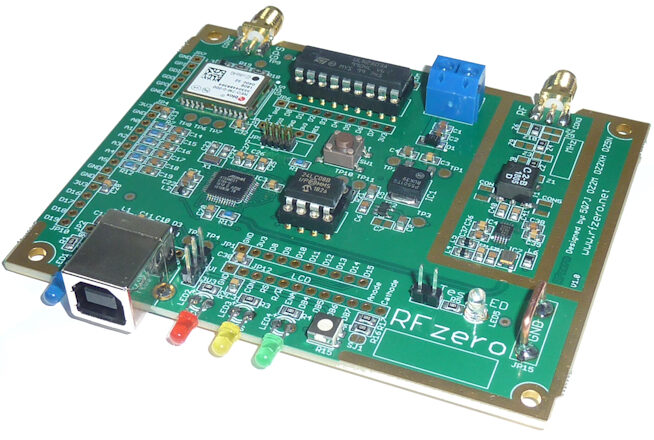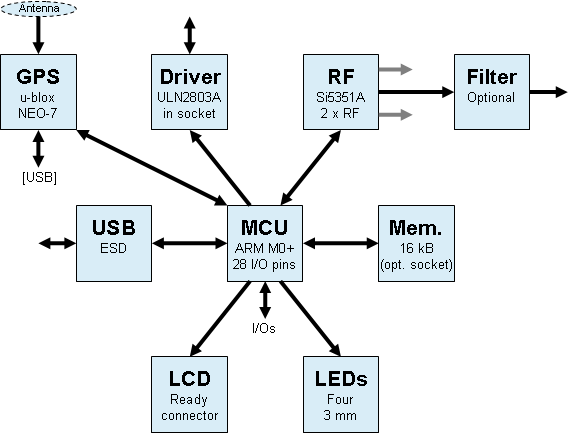The RFzero™ board is an Arduino compatible GPS based Si5351A RF signal source. The typical use of the RFzero™ is as a beacon (IBP, SPB, CW, FT8, JT9, PI4 and WSPR), signal generator, VFO, Qatari Oscar 100 dual LO or a low cost 10 MHz GPSDO. A dozen of programs (sketches) are integrated into the Arduino IDE for easy upload to the RFzero™ so you don’t need to write the software yourself.

The RFzero can generate frequencies from 2605 Hz and beyond 200 MHz. At the same time 28 I/O pins are available and eight of those are via an ULN2803A power driver. The programming and configuration is done via the USB port.
The RFzero has been developed for radio amateurs, RF enthusiasts and everyone else who wants to extend the Arduino skills in combination with RF. The RFzero™ board is largely compatible with the Arduino Zero and Arduino M0 boards, however, it has been carefully designed for flexible use in RF applications and with attention to the frequency spectrum and stability performance.
The RFzero functional block schematic.
 Using the RFzero you can learn how to program an RF device and other electronic circuits or you can learn about RF circuits if you are already skilled in software development. The setup is very flexible, you can roll your own programs from scratch or you can use the RFzero™ library and example programs together with the Arduino Integrated Development Environment (IDE).
Using the RFzero you can learn how to program an RF device and other electronic circuits or you can learn about RF circuits if you are already skilled in software development. The setup is very flexible, you can roll your own programs from scratch or you can use the RFzero™ library and example programs together with the Arduino Integrated Development Environment (IDE).
The RFzero key features are
- GPS
- u-blox NEO-7M GPS receiver
- On-board pre-amplifier supply via coax
- SMA female input
- On-board header for GPS data access from other units
- Optional USB port directly to the GPS e.g. for computer time keeping
- RF
- Si5351A RF chip clocked by a 27 MHz and 10 PPM oscillator
- Fundamental frequencies from 2605 Hz to 200 MHz – usable up to 280 MHz but outside SiLabs specifications
- Harmonics can also be used with reduced spectrum performance, e.g. WSPR on 1 GHz is possible
- Usable for PI4 on 10 GHz via x96 multiplier
- Frequency resolution can be as low as 1 mHz on any fundamental frequency
- Clock frequency measured continuously at 27 MHz for maximum accuracy
- Separate clock oscillator for maximum frequency stability
- Push-pull coupled outputs for more output and lower even harmonics, or
- Combined outputs for two-tone signals, or
- Quadrature I/Q outputs via U.FL sockets
- On-board pads for custom filter
- On-board RF decoupling
- RF section can be further shielded
- Separate voltage regulator for the RF section
- Four layer PCB for optimum RF performance
- SMA female output
- 13 dBm output 400 kHz to 200 MHz
- Micro controller
- Arduino compatible (Arduino Zero and Arduino M0)
- 32 bits ARM M0 processor running at 48 MHz and 10 PPM crystal clock and with 32 kB SRAM
- 1 kB EEPROM in socket for easy change
- USB port, with ESD protection, for programming and controlling purposes
- ARM Cortex connector
- Four SPI ports
- Four I2C/Wire ports
- Five serial ports
- One Real Time Clock
- Four status LEDs (on, TX, GPS PPS and GPS valid)
- On-board LCD connector for either 3,3 V or 5 V LCD with contrast and backlight control
- 28 I/O pins
- Up to eight 12 bits analog inputs
- One 10 bits analog (DAC) output
- The digital circuit has its own voltage regulator
- Darlington power driver IC ULN2803A in socket e.g. for controlling relays
- On-board test LED
- Possibility to add a shield for additional functionality or expansion
- On-board ground loop for alligator clip
- 11 test points for easy debugging
- Half Eurocard PCB size that fits into a variety of boxes including a metal sheet box (Weissblechgehäuse) for best RF shielding
- Power supply via USB or 5 V to a terminal block
Download a RFzero presentation here.
The RFzero has been designed with spectral performance in mind while using the cost effective Si5351A digital clock generator. However, if spectral performance is critical, e.g. for a 10 W or higher power beacon, transmitter or VFO, the Next Generation Beacons platform is the right choice but it is also in a different price range. Therefore you should see RFzero as a low cost and fair performance RF device.
The RFzero also has a user group at Groups.io.
If you want to add even more peripheral devices sites like eBay has a large selection to chose from. Please feel free to getinspired from the Shop.
